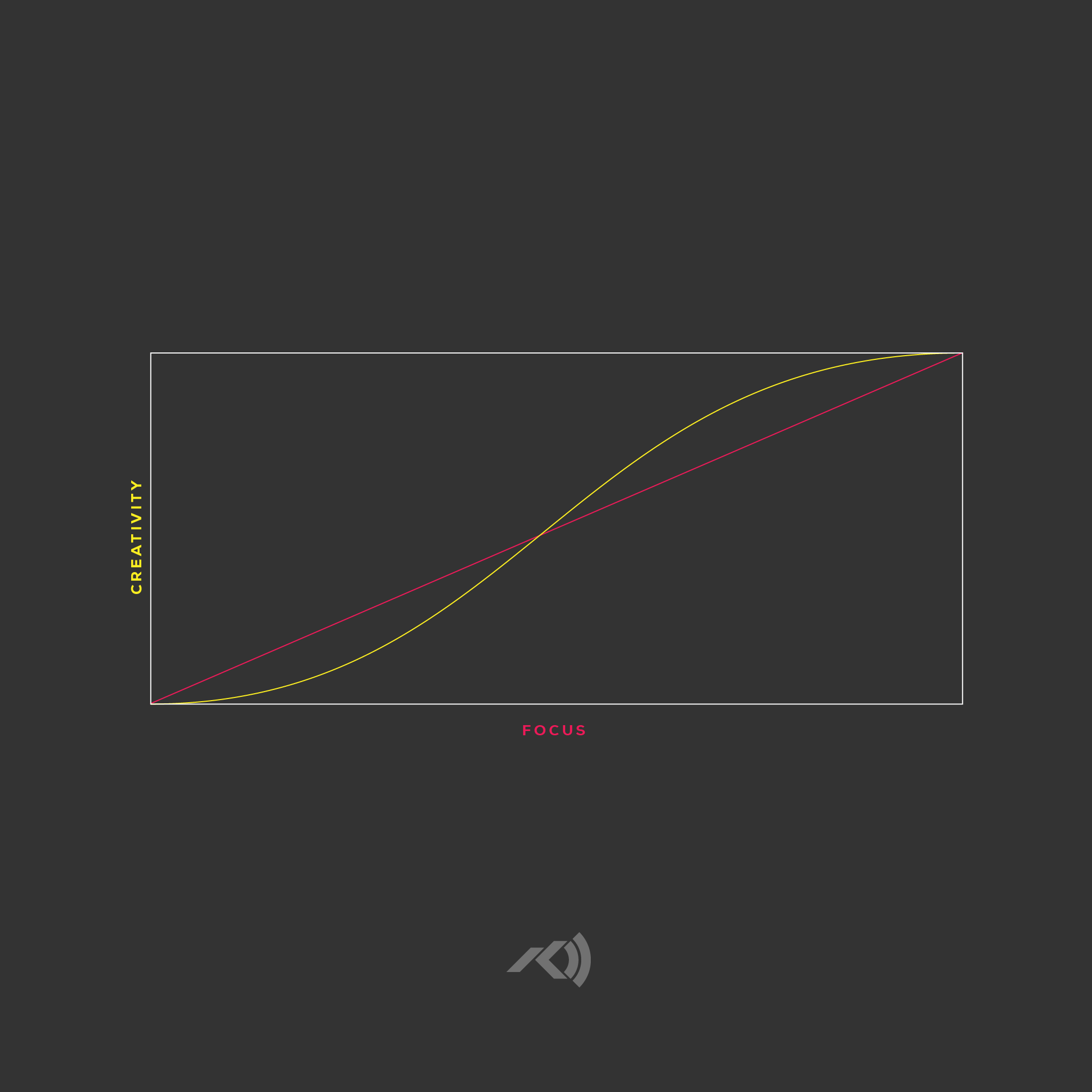You don’t have to stay stuck.
If you’re reading this, you probably understand creative people aren’t just musicians, painters, and poets. A creative person is anyone who can solve a complex problem in a novel way.
Some people only need to be creative occasionally and in short bursts. But many of us need to access our creativity at a moment’s notice and over long periods.
We need to know how to flip the switch of inspiration and get to work at any time.
Last week, we talked about how to prepare the soil where creativity can grow. We all have to:
- Create energy through diet, exercise, and rest
- Mind our mindset through practices that keep us positive and focused
- Invest attention by eliminating distractions and filling our creative wells
Here, we’ll look at how to find an endless spring of inspiration in the moment through three dialectics (opposites that hold the answer in their tension):
- Should & Could
- Pressure & Focus
- Make the Grid & Break It
This is how to become more predictably creative.
Should & Could
When you’re stuck on a creative problem, start by eliminating the word “should” from your thinking:
- What should this be?
- What should I do?
- How should I tackle this problem?
“Should” implies there’s a single, perfect answer. Don’t buy into that line of thinking.
Creative problems never have one answer.
Open your mind and remove some pressure by asking yourself, “What could this be?” Or, “How could I approach this problem?”
But if all of those possibilities leave you feeling overwhelmed, here’s what you “should” do: Expand, then contract.

STEP 1: Start with expansion.
Investigate as many possibilities as you can. In other words, explore all of the “coulds.” Take the time to get through all of your ideas without pausing to judge them. You can’t expand and contract (or edit) at the same time!
It can be useful to say to yourself or others, “Let’s explore all of the bad and obvious ideas first.” Often, the “bad” ideas aren’t so bad after all. You just needed permission to get them out of your head.
STEP 2: Review what you have.
Sort through all the material you’ve generated so far. What is working? Why? That leads you to…
STEP 3: Contraction.
Hopefully, you’ve been ignoring your inner editor so far. That voice is helpful, but it often speaks from a place of fear and insecurity. Paying attention to it too early in the process will hold you back.
But now that you’ve released the pressure to find the “perfect” idea, allow that voice to speak up. Of all the ideas you’ve generated, keep what you like, and throw out the rest. You may even find ways to combine disparate ideas that, though they aren’t great ideas on their own, have elements that will work well together.
Finally …
STEP 4: Find more inspiration!
Once you have a set of ideas you’re happy with, do some research, see what others have done before you, and start to expand again.
Repeat the process as many times as you need. You may only be able to go through one cycle, but that’s okay.
A little time pressure can force you to make quality decisions more quickly.
Pressure & Focus
Creative people have a checkered past with the concept of the “looming deadline.” Sometimes, a looming deadline will help me do my best work. Other times, it squeezes the life out of my creativity!
But when I consider how looming deadlines affect my creative output, I see it works on a bell curve.

When there’s no pressure or sense of urgency, my creativity runs at low tide. If there’s too much pressure, though, it chokes out my ability to innovate.
What most of us need to find is that middle zone—where pressure boosts creativity.
Secondly, I find a strong correlation between focus and creativity. If I’m distracted, wondering if I should be doing something else or checking one of the various feeds vying for my attention, I’m less creative.

I find that the effect of a looming deadline is this: When the pressure increases, my focus increases, too.
The trick is to learn to boost your focus while, at the same time, harnessing pressure so it doesn’t overwhelm you.
Here’s how:
- Make a plan, choose your priorities. Working from a list removes the distraction of wondering whether you’re focused on the “right” thing. It allows you to be fully engaged in the task you already decided was most important.
- Focus on one thing at a time and turn off other noises. Cell phone? Notifications? Slack feed? Mute them!
- Evaluate your pressure and focus. If you’re running up against too many deadlines, your ability to focus will decrease. Always make sure you’re realistic about how much time you have. And if you don’t have enough time, you can always…
- Lean on your team. We have a great group of designers, developers, writers, and project managers here at ArtSpeak. If you have a great team, get help. Ask for an extension, delegate, bounce ideas off someone you trust, or get help managing your priorities.
The goal remains a clear focus with the proper amount of pressure. If one or the other is stifling your productivity, make adjustments as quickly as you can.
Make the Grid & Break It
Once you have the proper amount of focus and pressure, here are ways to keep generating ideas when you come up dry.
Invent a new boundary.
When all of the “coulds” get overwhelming, add a rule or constraint that will limit the number of possibilities. If you’re a designer, you might ask yourself:
- What if I could only use triangles?
- What if I limited myself to one color?
- What if I was only allowed to use a tool I don’t typically use?
Constraints like these, though artificial, can get you moving again. If you find the restriction isn’t helpful, you can always throw it away later.
Look for “the adjacent possible.”
No one could develop a flying machine until others had first:
- Discovered the principles of aerodynamics
- Invented a lightweight powered motor
This principle, which author Steven Johnson calls “the adjacent possible,” says innovation emerges through a combination of pre-existing ideas.
That’s encouraging. None of us has to start from scratch!
The more you fill your creative toolbox with a variety of ideas, techniques, and tools, the more open you can be to “the adjacent possible.”
For example, many of the logos we create will start with pencil and paper, then move to Adobe Illustrator. This is a tried and true method, and we don’t plan on doing away with it.
But recently, one of our designers, Uriah Fracassi, decided to create a logo with a bamboo brush he had been experimenting with. He made a huge mess in his kitchen, but the result was a unique and beautiful logo the client loved.
Dabble. Take in a diversity of voices and ideas. Try new artforms. When you do, you’ll open yourself up to the adjacent possible.
Trust ideas will grow in your “Mind Garden.”
This concept comes from our Branding Champion, Eric Hungerford.
You alone are not responsible for the solution to every creative problem. That’s too much pressure to put on yourself! Ultimate creativity comes from outside of us.
Think of it this way.
When you want to grow vegetables, you take care of the soil and plant the seeds. But you have nothing to do with what grows from those seeds.
The same is true with your mind.
Your subconscious mind is a supercomputer. When you load in the questions, your subconscious will go looking for the answer while your conscious mind is doing something else.
Or, to go back to the garden metaphor,
if you take care of the soil of your mind
and plant the right seeds,
the answer to the creative problems you face will grow without your conscious help.
Neuroscience confirms this fact, but it’s also a testament to the Holy Spirit’s creative work in our lives.
Plant the seeds, and trust they’ll grow in your Mind Garden.
If you need some music to find your garden, allow Mr. Rogers himself to be your guide.
Stay Creative
ArtSpeak Creative wants to do our part to give life changers the tools they need to reach more people.
Are you a pastor, ministry leader, responsible for a creative team, or an influencer? Do you always need to keep your mind filled with great ideas?
Let’s stay connected. Fill out the form below, and we’ll keep in touch with lots of great ideas to keep you firing on all cylinders.

